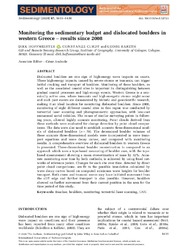Monitoring the sedimentary budget and dislocated boulders in western Greece – results since 2008
DOI: https://doi.org/10.1111/sed.12723
Persistent URL: http://resolver.sub.uni-goettingen.de/purl?gldocs-11858/9421
Persistent URL: http://resolver.sub.uni-goettingen.de/purl?gldocs-11858/9421
Hoffmeister, Dirk; Curdt, Constanze; Bareth, Georg, 2020: Monitoring the sedimentary budget and dislocated boulders in western Greece – results since 2008. In: Sedimentology, Band 67, 3: 1411 - 1430, DOI: 10.1111/sed.12723.
 |
Dokument öffnen: |
Dislocated boulders are one sign of high-energy wave impacts on coasts. These high-energy impacts, caused by severe storms or tsunamis, can trigger initial cracking and transport of boulders. Monitoring of these boulders, as well as the associated coastal sites is important in distinguishing between gradual coastal processes and high-energy events. Western Greece is a seismically active area, where tsunamis and high-energetic storms might occur and such past events are documented by historic and geoscientific research, making it an ideal location for monitoring dislocated boulders. Since 2008, monitoring of eight different coastal sites in this region was conducted by terrestrial laser scanning and photogrammetric approaches, with low-cost unmanned aerial vehicles. The re-use of similar surveying points in following years, allowed highly accurate monitoring. Point clouds derived from these methods were evaluated for change detection by point cloud comparisons. The data were also used to establish accurate three-dimensional models of dislocated boulders (n = 70). The determined boulder volumes of these accurate three-dimensional models were incorporated in wave transport equations and wave decay curves, and compared with monitoring results. A comprehensive overview of dislocated boulders in western Greece is presented. Three-dimensional boulder reconstruction is compared to an approach which uses a tape-based measuring of boulder axes, with the tape-based measurement showing a mean overestimation of mass by 32%. Accurate monitoring over time by both methods, is achieved by using fixed networks of reference points. Changes for each site over time, detected by direct point cloud comparisons, are fit to the possible inundation calculated by wave decay curves based on computed minimum wave heights for boulder transport. Both storm and tsunami waves may have initiated movement from the cliff edge and further transport is also possible. However, boulders showed no further movement from their current position in the area for the time period of this study.
Statistik:
ZugriffsstatistikSammlung:
- Geologie [933]
This is an open access article under the terms of the Creative Commons Attribution-NonCommercial License, which permits use, distribution and reproduction in any medium, provided the original work is properly cited and is not used for commercial purposes.

